Testing the effectiveness of a novel, evidence-based weight management and lifestyle modification programme in primary care: the Healthy Weight Initiative
Scott Slater 1 * , David Lambkin 2 , Tracy Schumacher 3 , Annabelle Williams 1 , John Baillie 11 Hunter New England and Central Coast Primary Health Network, 11/125 Bull Street, Newcastle West, NSW 2302, Australia.
2 Hunter Medical Research Institute, New Lambton Heights, NSW, Australia.
3 Department of Rural Health, Faculty of Health and Medicine, The University of Newcastle, Tamworth, NSW, Australia.
Journal of Primary Health Care 14(1) 64-73 https://doi.org/10.1071/HC21065
Published: 13 April 2022
© 2022 The Author(s) (or their employer(s)). Published by CSIRO Publishing on behalf of the Royal New Zealand College of General Practitioners. This is an open access article distributed under the Creative Commons Attribution-NonCommercial-NoDerivatives 4.0 International License (CC BY-NC-ND)
Abstract
Introduction: Primary care prevention strategies that support and provide tools for general practice have the potential to slow and reverse rates of overweight and obesity.
Aim: To test the effectiveness of a novel 12-week, online, structured, evidence-based weight management and lifestyle modification programme in general practices.
Methods: Between August 2018 and March 2020, participants with a body mass index (BMI) ≥ 25 were recruited from general practices in the Hunter New England and Central Coast Primary Health Network region of Australia. Practices were randomly assigned to deliver a ‘low-intensity’ (LI) or ‘high-intensity’ (HI) variant of the programme. Practitioners were trained in programme delivery. The intervention involved weekly progress and accountability checks and scripted education sessions on evidenced-based nutrition, physical activity and lifestyle modification. The trial included follow-up evaluations at 6 and 12 months.
Results: In total, 695 participants were recruited from 26 practices. At the end of the 12-week programme, participants in the HI treatment arm lost an average of 3.2 kg (s.d. 3.8) and 29% (50/172) achieved clinically significant weight loss (>5% of initial body weight). Positive results were maintained at evaluations by participants in the HI treatment arm who attended, but only 31% of participants at 6 months and 21% at 12 months were followed up.
Discussion: Participant engagement and retention and practitioner workload burden are key factors in the design of weight management programmes in primary care. Many lessons can be obtained as a result of this trial, and programme adjustments have been identified to improve its delivery model.
Keywords: chronic disease prevention, evidence-based weight management, general practice, GP-led weight management, nutrition, obesity, physical activity, primary care.
Introduction
Overweight and obesity rates are high in the Hunter New England and Central Coast Primary Health Network region.1 In 2018, high body mass-attributable hospitalisations in this region were the second highest among Primary Health Networks across New South Wales, with males recording 1035/100 000 hospitalisations due to obesity and females 734/100 000.1 Additionally, 2017–18 age-standardised obesity rates are higher in the Hunter New England and Central Coast Primary Health Network than both state and national rates. Obesity affects not only a person’s health, but it also has substantial health care and economic costs for Australian communities.2
Weight management interventions in Australian primary care have had limited uptake and weight loss success.3 Mostly, this is also the case internationally. A meta-analysis of results from 15 international randomised controlled trials (RCTs) found a mean weight loss of 1.36 kg at 12 months and concluded that behavioural weight loss interventions in primary care yield very small reductions in body weight, which are unlikely to be clinically significant.4 This absence of success, along with other general practitioner (GP) barriers such as perceived insufficient time and self-efficacy, difficulty initiating weight conversations,3 lack of evidenced-based tools and effective and individualised treatment and referral options, affect GP-led weight management interventions in primary care.5 Taken together, these reasons may explain why weight management or weight gain prevention programmes in primary care have so far been limited.
| WHAT GAP THIS FILLS |
| What is already known: Currently, general practices in Australia do not have sufficient access to preventive evidenced-based models of care for the management of overweight and obesity. Several barriers exist regarding general practitioners (GPs) delivering preventive care and management of overweight and obesity. |
| What this study adds: This research provides evidence that GP-led evidenced-based weight management programmes in general practice have the potential to impact increasing overweight and obesity rates. All primary care settings should be strengthened by having access to evidenced-based models of care as part of an overall prevention strategy to address Australia’s overweight and obesity rates. |
Previous research suggests that type and level of care provided by clinicians in general practice varies and particularly, there are differences in care for overweight and obese patients provided by GPs, practice nurses and specialised allied health practitioners (eg dietitians, exercise physiologists).6 One reason for this may be that training varies in the specific areas of nutrition, physical activity and behavioural interventions required for successful obesity management.7 For GPs and practice nurses, there is only modest training in these areas compared to training given to specialised allied health practitioners.8 Even so, Australian research has shown that patients prefer their GP to play a role in their weight management, rather than taking medications or being referred to dietitians.9,10
According to the current National Health and Medical Research Council guidelines for the management of overweight and obesity in primary care, general practice is ideally suited to initiate and coordinate multidisciplinary weight management programmes.6 The guidelines also state that patients’ usual healthcare provider (GPs or practice nurses) should play a prominent role in initiating discussions, providing assistance in developing weight management programmes, referring when required, and monitoring and reviewing progress.6 Acknowledging this, along with the barriers highlighted above, strategies and tools that empower GPs by providing obesity-focused practice resources and education to practice staff, could help mitigate perceived barriers and are seen as critical to implementing effective weight gain and chronic disease prevention programmes in general practice.11
This paper describes the effectiveness of the Healthy Weight Initiative in general practices in the Hunter New England and Central Coast Primary Health Network region. Primary care in the study region currently lacks ‘prevention-focussed’ evidenced-based models of care for the management of overweight and obesity. Our goal was to address this gap. Our primary aim was to test the effectiveness of a novel model of care; an online, structured and scripted evidence-based weight management and lifestyle modification programme running over 12 weeks. Our prevention-focussed hypothesis was that intervening before overweight or obese persons develop a related chronic disease will reduce health and economic burdens to the healthcare system and improve long-term health outcomes for individuals.
Methods
Study design
A clustered RCT was conducted at selected general practices across the Hunter New England and Central Coast Primary Health Network region between August 2018 and March 2020. We use the template for intervention description and replication (TIDieR) checklist for replicability to present information about the intervention.12
The Healthy Weight Initiative was designed as a ‘scripted’ practitioner question and patient answer model that could be delivered by GPs, practice nurses, and allied health staff of study practices, mitigating variation in practitioner knowledge, skills and confidence in delivery of healthy eating, physical activity and lifestyle modification advice. ‘Scripting’ the programme also meant that many general practices with limited capacity and staff (eg small rural practices) could deliver the programme.
General practice and patient recruitment
General practices were recruited through an expression of interest (EOI) process. Practices responding to the EOI were screened for their capacity and ability to deliver the programme. The practices were stratified by Remoteness Areas13 and then randomly allocated to one of two study arms by Hunter Medical Research Institute’s statisticians. Practices were financially compensated for their time delivering the programme to the equivalent of a standard GP consultation or practice nurse general visit.
Patients were recruited through self-enquiry, identification and invitation by their GP or via programme promotional material placed in waiting rooms. Inclusion criteria reflected the study’s prevention-focussed hypothesis and were: understanding conversational English; aged 18–65 years; body mass index (BMI) ≥ 25, without a diagnosed pre-existing chronic disease (heart disease, diabetes, cancer and stroke); no history of eating disorders; not currently pregnant or breast feeding. Australia’s overall poor dietary food intake10 and physical activity behaviours,11 regardless of weight and BMI, along with the limitations of the BMI measure,12,13 were other reasons for a BMI ≥ 25 being chosen over a >27 or >30 BMI inclusion criterion.
Programme delivery
After the study processes were explained and patients consented to participate, reception staff booked participants’ first session and emailed (via an online ‘email automation’ service) an introductory welcome letter that contained further information and an evidenced-based study resources toolkit. The information pack included three hard copy resources: a 24-h food diary; the Depression, Anxiety and Stress Scale – 21 Items (DASS-21) questionnaire,14 a validated screening scale; and the Three Factor Eating questionnaire-R1815 to screen for disordered eating behaviour. Participants were not paid for their involvement in the trial, but they were supplied with a wearable activity tracker (Garmin) wrist band or a pedometer (if Garmin was unsuitable) for tracking physical activity.
The two study arms were ‘low-intensity’ (LI; control) and ‘high-intensity’ (HI; intervention). Both arms received the same week 1 (baseline), week 12 and evaluation assessments and programme resources. The HI arm had 10 additional weekly measurements, evidenced-based education and support sessions on healthy eating, physical activity and lifestyle modification. Programme delivery and topics are shown in Table 1. The Healthy Weight Initiative programme baseline, final and evaluation health assessments included nutritional and physical activity level assessments, mental health screening using the DASS-21, eating behaviour assessment using the Three Factor Eating questionnaire-R18 and patient goal setting (healthy eating, physical activity and lifestyle choices) focussing on improvement rather than meeting the Australian Guideline for healthy eating and physical activity goals.16,17
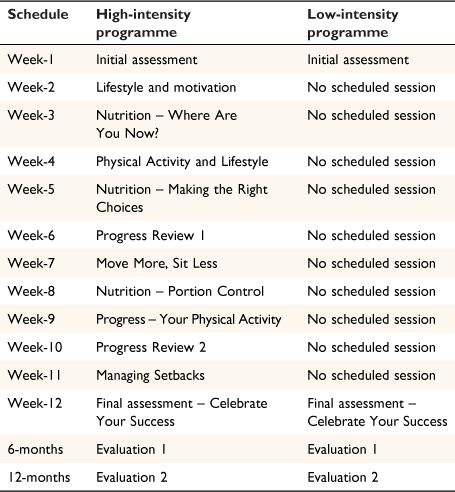
|
The Healthy Weight Initiative programme was delivered by GPs, practice nurses and allied health staff in each practice through face-to-face visits in the practice. Trial data were captured and participant progress was tracked through a modified version of the Visual Fitness Planner, which was uploaded to the computers in participating clinicians’ rooms before practitioner training. The original Visual Fitness Planner is a commercial gym software ‘sales generational tool’ (https://vfp.us/). Intended to inspire positive behaviour change, the software produces a three-dimensional image of individuals from anthropometric measurements to provide an objective view of each individual’s body.18 The programme’s contents were drawn from Australian physical activity and healthy eating guidelines16,17 and other evidenced-based federal and state government web pages, guidelines and health promotion materials. The software was modelled and constructed by Visual Fitness Planner developers in the United States.
Clinician training
Practice staff of both study groups received 1-h training in facilitating the programme. Training involved a Primary Health Network Healthy Weight Initiative project officer taking the practice-nominated clinicians through the programme scripting and entering fictitious patient responses. During the training, the project officer answered practitioner questions and provided tips for delivery, with instructions to refer the participants to the resources toolkit if practitioners were unable to answer participants’ questions using their existing professional expertise. Healthy Weight Initiative resources are an online amalgamation of potential patient questions, answered by weblinks that direct participants to publicly available government guidelines and resources for healthy eating, physical activity and making better lifestyle choices. This approach encouraged patient ownership and placed the onus and accountability on participants, an essential component of any weight management programme.6 Monthly support from the project officers (via phone and email) was also available to all practitioners throughout the trial.
Primary and secondary outcome measures
The study’s primary outcome was weight loss over 12 weeks, measured in kilograms to 1 decimal point using the practices’ own digital scale. Height was measured using the practices’ own stadiometer and BMI was calculated (weight in kilograms divided by height in metres squared). Clinicians were asked to take all measurements using the same equipment throughout the programme.
The secondary outcome was waist circumference in centimetres (cm) measured using a non-extensible steel tape, at the narrowest point between the lowest rib and the top of the iliac crest or hipbone. Patient and practitioner experience was measured through a survey developed by the Primary Health Network.
Statistical analysis
The sample size was powered for the primary outcome of weight loss and each practice recruited a nominal maximum of 48 patients directly from their usual general practice consultations at random. The study was powered to detect a change in weight of 0.25 s.d. (Cohen’s d = 0.25), with 80% power at a P-value of 0.05. We estimated this would require 250 patients in both treatment arms: 50 participants from five practices. To account for the clustering effect, a design effect of 2 was calculated (intra-cluster correlation = 0.02), which increased the sample to 500 in both treatment arms: 50 participants from 10 practices. To account for some loss to follow up, the number of practices recruited was increased to 13 per treatment arm.
The intention-to-treat (ITT) analysis included all participants who completed baseline demographic data collection (age, gender, and Aboriginal and Torres Strait Islander status) and who were eligible based on their baseline weight measurement (BMI ≥ 25). For missing data, multiple imputation under the missing-at-random assumption fulfilled the ITT requirement. Fixed effects were included for potentially confounding demographic variables and for the stratification variable geographical remoteness (ARIA+). The analysis reports data in mean ± standard deviation (s.d.) format.
Change in weight from baseline to 12 weeks was assessed using analysis of covariance (ANCOVA) linear mixed effects regression, both as absolute weight loss and percentage weight loss. Absolute weight loss was adjusted for baseline weight. Change in waist circumference was assessed using the same methodology, with adjustments for their baseline values. Survey responses were assessed using ordinal logistic regression between the two treatment arms.
Ethics approval
The Healthy Weight Initiative trial was approved by the Hunter New England Human Research Ethics Committee (2019/ETH01191). This clustered randomised control trial was undertaken with appropriate informed consent of participants or guardians through each practice at sign up.
Results
There were 29 general practices that responded to the initial EOI process. Subsequently, three withdrew their interest, deciding that they would be unable to deliver the programme as required. In total, 26 practices were recruited into the trial. Baseline practice characteristics are shown in Table 2. The programme was delivered by 22 practice nurses, two GPs, one practice nurse and GP combination, and one dietitian.
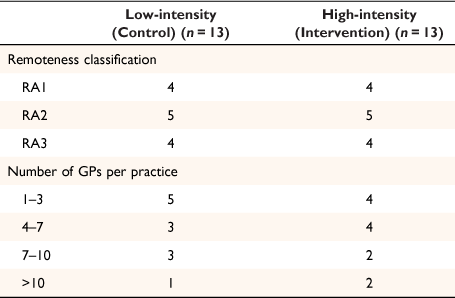
|
From the 26 practices, 695 participants (ITT population) were recruited to participate: 547 female (79%) and 148 males (21%). We do not know how many potential participants declined involvement. Of the total ITT population, 390 participated in the HI study arm and 305 participated in the LI arm. Patient mean age (s.d.) was 45.6 (12.6) years. The ITT population included 71 (10%) participants who indicated they were of Aboriginal and or Torres Strait Islander descent. The demographics by Remoteness Classification (RA coding) for the ITT population showed that the number of participants who resided in the RA1 (major cities of Australia), RA2 (inner regional Australia) and RA3 (outer regional Australia) areas was 240, 344 and 111 respectively. At baseline, 557 (80%) participants recorded a BMI indicating obesity (HI: n = 310, LI: n = 247). Baseline characteristics, practice and participant retention are displayed in Table 3, Figs 1, 2.
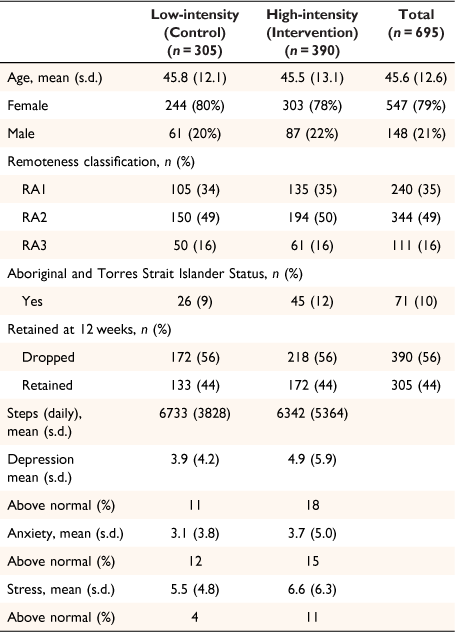
|
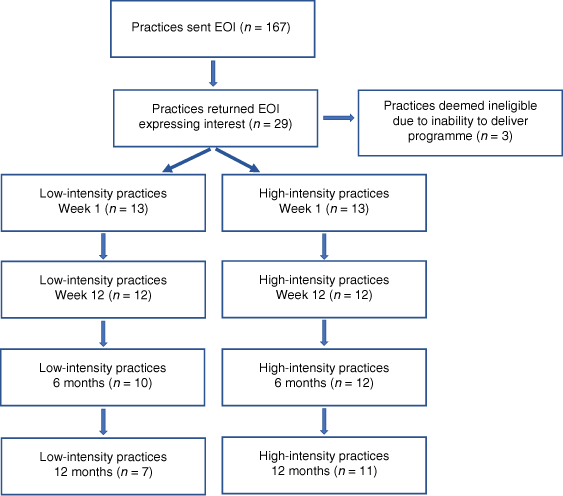
|

|
Primary and secondary outcomes
Participants in the HI arm lost more weight than participants in the LI arm. The amount of weight lost depended on the participant’s baseline weight, with heavier participants losing more weight than lighter participants. Over the 12 intervention weeks, average weight loss was 3.2 kg (s.d. 3.9) for the HI arm and 1.7 kg (s.d. 4.1) for the LI group. After accounting for other effects (gender, age, Indigenous Australian status), participants in the HI arm lost 1.4 kg (95% CI = −2.312, −0.505; P = 0.003) more weight and an estimated 1.46% (95% CI = −2.420, −0.500; P = 0.004) more than participants in the LI arm. Almost one-third (29%) of the HI group lost a clinically significant (>5% of initial body weight) amount of weight (n = 50/172), compared to 17% of the participants (n = 22/133) in the LI group.
Waist circumference decreased in both arms, but with greater effect in the HI group, who lost an average of −3.9 cm from their waist circumference compared to an average of −2.2 cm for the LI group. After adjusting, HI participants’ waist circumference reduced by an estimated 1.33 cm (95% CI = −2.562, −0.088; P = 0.036) more than participants in the LI arm. The primary and secondary outcome results are shown in Table 4.
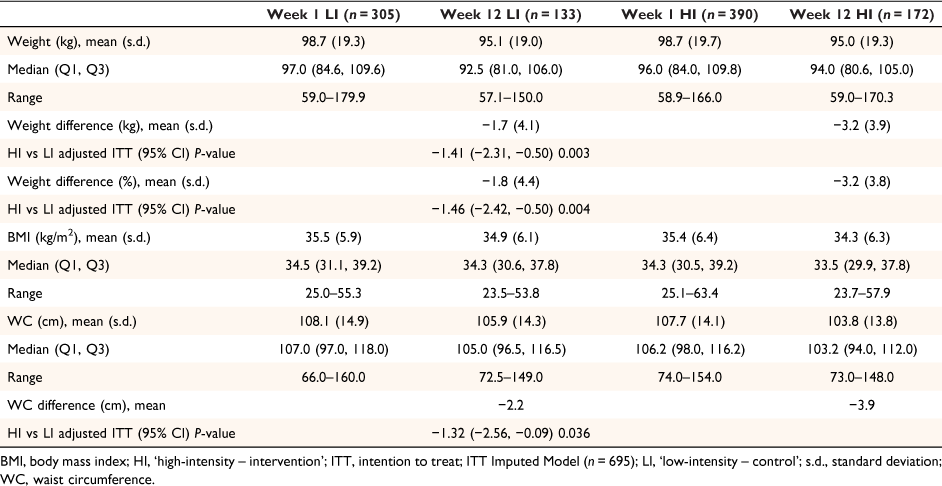
|
Most responded positively to the participant experience survey in both treatment arms of the study, but participants in the HI arm responded more positively. More than 90% of participants in the HI group provided the maximum positive response to most questions (11/16), especially questions in relation to the clinician’s delivery of the programme. The scores are shown in Table 5.
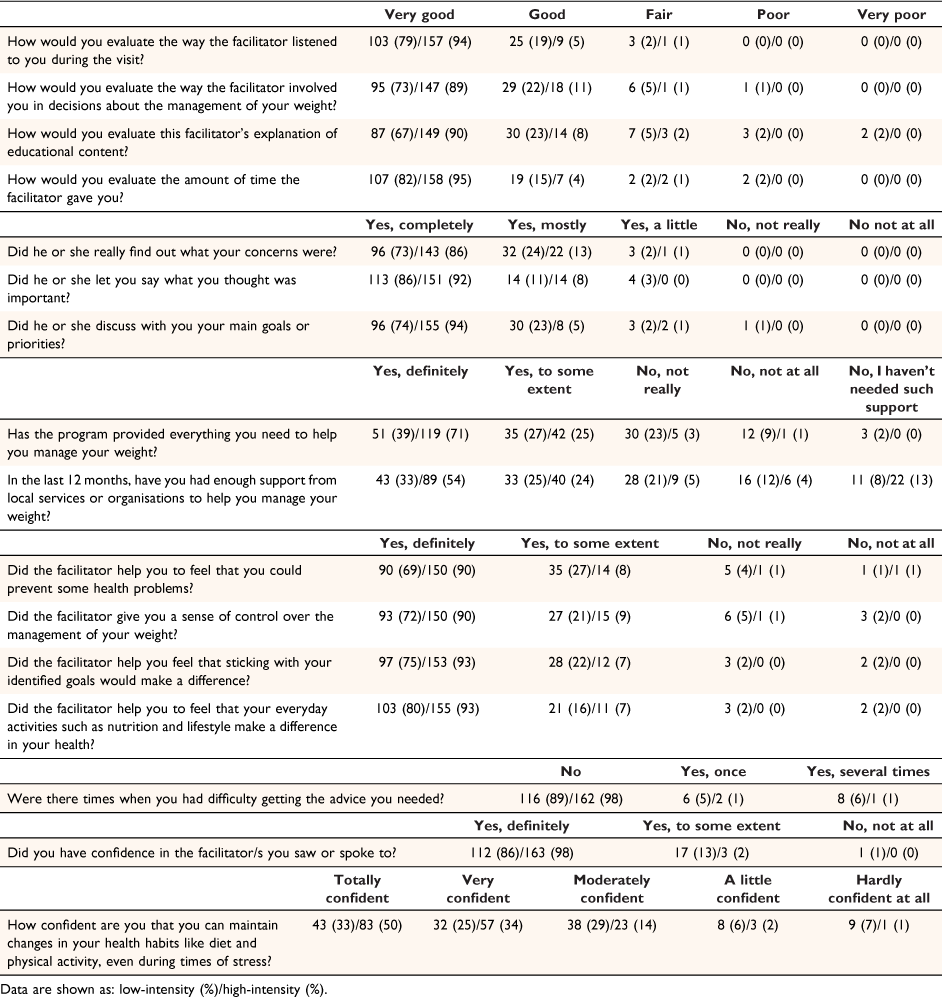
|
Only 15 clinicians at seven practice locations completed the survey, so there was insufficient data to analyse these responses comparatively and meaningfully. The scores are shown in Table 6.
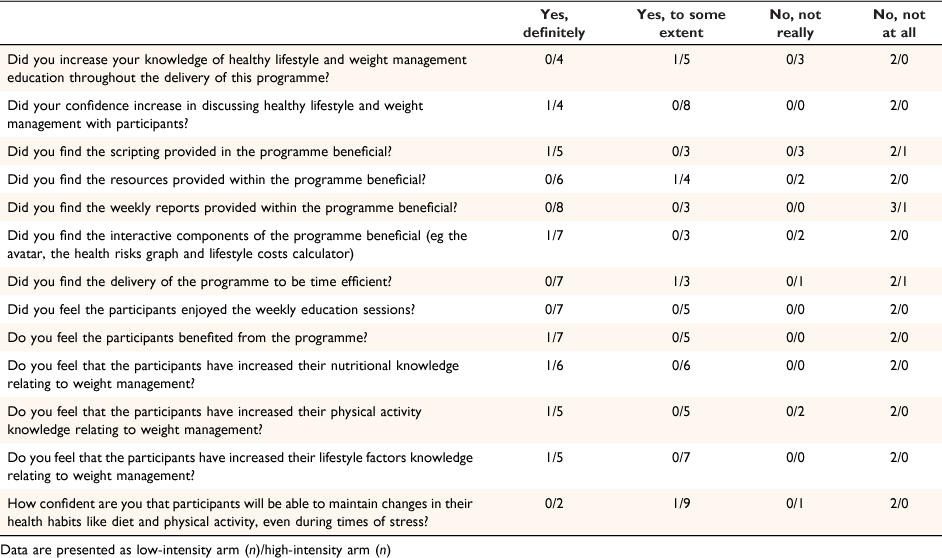
|
Follow-up assessments at 6 and 12 months
Outcome data collected at the 6- and 12-months evaluations were not modelled due to the high dropout rate making assumptions of representativeness impossible. At 6 and 12 months, in the HI arm, 63.6 and 73.3% respectively dropped out and in the LI arm, 77 and 85.2% respectively dropped out. For data collected at 12-weeks' post intervention, it was feasible to assume that the data were missing at random and could be accounted for by patient characteristics measured at baseline. However, at 6 and 12 months, it would be much more likely that the data were not missing at random.
Average weight and waist circumference losses achieved at 12 weeks were recorded at both evaluations. Of participants who returned in the HI group, the average weight and waist circumference loss of 3.8 kg and 4 cm at 6 months were greater than the recorded results at 12 weeks. Results on primary and secondary outcomes at the 6- and 12-month evaluations are shown in Table 7.

|
Discussion
This study’s aim was to test the effectiveness of a novel model of care developed to support general practice in managing the care of people in the Hunter New England and Central Coast Primary Health Network region who were overweight and obese. Results at the end of the 12-week programme were promising and clinically significant for 29% of the participants in the intervention (HI) group (n = 50/172). Positive results were also demonstrated in participant average weight and waist circumference levels, with the HI group averages showing −3.2 kg weight, −3.9 cm waist circumference losses at 12 weeks. These group averages were maintained at 6- and 12-month evaluations by participants in the HI group who attended the follow-up sessions, but participant losses to follow-up were a major issue across both arms.
The results show that the Primary Health Network’s Healthy Weight Initiative demonstrated similar results to other general practice weight management interventions internationally. For example, results from a counterweight study in the United Kingdom showed an average 3.0 kg weight loss, and 26.1% of participants who attended an evaluation achieved a clinically significant weight reduction at 12 weeks.19 Similarly, the US National Institutes of Health review study of 29 RCTs20 and the Think Health! Study21 both found a net (mean) weight loss at 12 months of −3.3 kg for participants who returned for their evaluations. Results of the Healthy Weight Initiative were also similar to an Australian GP-led weight management programme, ‘the Change Program’, which demonstrated that one-third of the participants lost >5% of their initial body weight.9,22 We also acknowledge that commercial 12-week weight loss interventions often achieve better results than primary care weight management interventions;23 however, there are often considerable differences between the two with regards to time (length) of sessions,24 type of support provided, patients’ ability to pay, and evidence-base, potentially limiting comparability in most circumstances.
Although there were some positive aspects and results in this trial, there were also important challenges and concerns related to loss to follow up and poor survey response rates from practitioners. A similar 12-week obesity intervention in primary care in the UK (the POWeR study) found that scheduled ‘basic nurse support’ at week 2, week 4 and 3 months after baseline (three support sessions in total) proved to be the optimum number of patient–practitioner support sessions over the 12 weeks.25 Our results, which show that 17% of the LI group also achieved clinically significant weight loss with two sessions (across 12 weeks), indicates that a smaller number of face-to-face sessions can also achieve positive results. Finding the middle ground with scheduled face-to-face sessions is likely to be important in mitigating patient and practice drop out in primary care weight management programmes.
Despite the regular (usually monthly) check-ins between the Primary Health Network staff and practitioners, which occurred in person where possible and phone or email otherwise, participant loss to follow up was considerable. This leads to two key questions: why did the loss to follow up occur?; and what other factors need considering when introducing and implementing a weight management programme into a general practice? Research suggests that similar weight management trials (in terms of numbers enrolled, length of study, facilitation methods) in primary care often have large losses to follow up and issues with patient retention.19 In contrast, studies with much smaller participant numbers often maintain higher retention rates,9,26 suggesting that future research or iterations of the programme would benefit from better screening of practices, potentially including a ‘readiness for change’ assessment for participants before enrolment, and greater attention to mitigating participant drop out and practice disengagement.
With respect to future opportunities to improve implementation, Primary Health Network staff have identified potential adjustments to improve programme facilitation in the practices and mitigate the high dropout rates seen in this study. These adjustments are based on clinician feedback and findings from other similar studies. They include: extending the initial training session to include health coaching skills, motivational interviewing and readiness for change; changing face-to-face sessions for online modules and having a maximum of four to five face- to-face sessions over the 12 months; better identification and screening of practices and practitioners on their ability to deliver the programme; including more relevant evidenced-based chronic disease prevention information in the resources provided; and altering the programme to target participants with a BMI > 30 and accommodate patients with co-morbidities.
There are two benefits of altering the number of sessions. First, it would reduce patient and practitioner workload, which may have contributed to the high dropout rates. Second, it would also allow exploring the feasibility and acceptability (possibly through further research) of a more sustainable financial model whereby practices could leverage GP management plan (GPMP) item numbers and the MBS billing system. This financial factor would encourage practice owners to implement this type of model in their general practice, and also would support GPs in addressing some of the barriers associated with weight management in primary care while adhering to the current guidelines for the management of overweight and obesity.6
Such adjustments would provide general practice (if the trial’s many lessons are built into a new modified version) an evidenced-based new model of care that addresses barriers to change in practice27,28 and provide the opportunities in primary care for weight management raised by the Department of Health’s National Obesity Summit.29 These opportunities include providing GPs a scripted tool to support them in talking to patients about their weight, to weigh their patients, use GP management plans for treating obesity, and improve training and support, which will also contribute to improving GPs’ engagement with the complexities of obesity and its comorbidities.29 This trial provides valuable lessons on what works for the programme (and also what needs improving) in developing a tool to support general practice and GPs in managing overweight and obesity. The Healthy Weight Initiative was a pilot programme and this trial suggests that major modifications and further research into refining the programme would be beneficial.
Strengths of this study include an evidenced-based programme design that supports current recommendations and guidelines, and multiple imputation for missing data in statistical analyses due to the high dropout rates. This study had several limitations. The effect of practitioner motivation could not be assessed in the primary and secondary outcome results. We did not conduct a cluster analysis to account for within- and between-practice variation in terms of staffing and practitioner expertise. These limitations could have been managed by improvements to practice recruitment, practitioner training protocols, and the trial’s design. Although positive weight loss group averages were maintained at follow up by patients who attended, changes to optimise retention and attendance are needed in future programme developments.
In conclusion, the Healthy Weight Initiative programme provides general practice support organisations a baseline for developing a new model of care option for weight management in efforts to address the overweight and obesity rates in the Hunter New England and Central Coast Primary Health Network region. The HI arm demonstrated larger weight loss benefits than the LI arm, which were sustained by engaged participants. The large participant loss to follow up suggests that participant retention and practitioner workload are key factors in the design of primary care weight management programmes. All primary care settings should be strengthened by having access to evidence-based weight management programmes as part of an overall prevention strategy to address Australia’s overweight and obesity rates. Overall, the trial was a success regarding lessons learned and identifying programme adjustments needed in building a tool to support GPs and general practice in delivering an evidenced-based weight management programme.
Data availability
The data that support this study will be shared upon reasonable request to the corresponding author.
Conflicts of interest
The authors declare no conflicts of interest.
Declaration of funding
This research did not receive any specific funding
Acknowledgements
We would like to thank the study participants, practice nurses, allied health professionals and the GPs who facilitated the programme, members of the Healthy Weight Advisory Group, Hunter Medical Research Institute for contributing to the study design and evaluation, and the Primary Health Network staff involved in the development and facilitation of the project.
References
[1] NSW Ministry of Health. NSW Population Health Survey Results 2018.Centre for Epidemiology and Evidence: NSW Ministry of Health; 2018.[2] Colagiuri S, Lee CMY, Colagiuri R, et al. The cost of overweight and obesity in Australia. Med J Aust 2010; 192 260–4.
| The cost of overweight and obesity in Australia.Crossref | GoogleScholarGoogle Scholar | 20201759PubMed |
[3] Jansen S, Desbrow B, Ball L. Obesity management by general practitioners: the unavoidable necessity. Aust J Prim Health 2015; 21 366–8.
| Obesity management by general practitioners: the unavoidable necessity.Crossref | GoogleScholarGoogle Scholar | 26349423PubMed |
[4] Booth HP, Prevost TA, Wright AJ, Gulliford MC. Effectiveness of behavioural weight loss interventions delivered in a primary care setting: a systematic review and meta-analysis. Fam Pract 2014; 31 643–53.
| Effectiveness of behavioural weight loss interventions delivered in a primary care setting: a systematic review and meta-analysis.Crossref | GoogleScholarGoogle Scholar | 25298510PubMed |
[5] Glenister KM, Malatzky CA, Wright J. Barriers to effective conversations regarding overweight and obesity in regional Victoria. Aust Fam Physician 2017; 46 769–73.
| 29036779PubMed |
[6] National Health and Medical Research Council. Clinical practice guidelines for the management of overweight and obesity in adults, adolescents and children in Australia. Melbourne: NHMRC; 2013. Available at https://www.nhmrc.gov.au/about-us/publications/clinical-practice-guidelines-management-overweight-and-obesity [Accessed 22 February 2022]
[7] Greaves CJ, Sheppard KE, Abraham C, et al. Systematic review of reviews of intervention components associated with increased effectiveness in dietary and physical activity interventions. BMC Public Health 2011; 11 119
| Systematic review of reviews of intervention components associated with increased effectiveness in dietary and physical activity interventions.Crossref | GoogleScholarGoogle Scholar | 21333011PubMed |
[8] Sturgiss EA, van Weel C, Ball L, et al. Obesity management in Australian primary care: where has the general practitioner gone? Aust J Prim Health 2016; 22 473–6.
| Obesity management in Australian primary care: where has the general practitioner gone?Crossref | GoogleScholarGoogle Scholar | 27816067PubMed |
[9] Sturgiss EA, Elmitt N, Haesler E, et al. Feasibility and acceptability of a physician-delivered weight management programme. Fam Pract 2017; 34 43–8.
| Feasibility and acceptability of a physician-delivered weight management programme.Crossref | GoogleScholarGoogle Scholar | 28122922PubMed |
[10] Tan D, Zwar NA, Dennis SM, Vagholkar S. Weight management in general practice: what do patients want? Med J Aust 2006; 185 73–5.
| Weight management in general practice: what do patients want?Crossref | GoogleScholarGoogle Scholar | 16842059PubMed |
[11] Forgione N, Deed G, Kilov G, Rigas G. Managing obesity in primary care: breaking down the barriers. Adv Therapy 2018; 35 191–8.
| Managing obesity in primary care: breaking down the barriers.Crossref | GoogleScholarGoogle Scholar |
[12] Hoffmann TC, Glasziou PP, Boutron I, et al. Better reporting of interventions: template for intervention description and replication (TIDieR) checklist and guide. Br Med J 2014; 348 g1687
| Better reporting of interventions: template for intervention description and replication (TIDieR) checklist and guide.Crossref | GoogleScholarGoogle Scholar |
[13] Australian Bureau of Statistics. Australian Statistical Geography Standard (ASGS): Volume 5 – Remoteness Structure (cat. no. 1270.0.55.005). Canberra: ABS; 2014. Available from: https://www.abs.gov.au/ausstats/abs@.nsf/mf/1270.0.55.005 [Accessed 22 February 2022]
[14] Henry JD, Crawford JR. The short-form version of the depression anxiety stress scales (DASS-21): construct validity and normative data in a large non-clinical sample. Br J Clin Psychol 2005; 44 227–39.
| The short-form version of the depression anxiety stress scales (DASS-21): construct validity and normative data in a large non-clinical sample.Crossref | GoogleScholarGoogle Scholar | 16004657PubMed |
[15] Chacko SA, Chiodi SN, Wee CC. Recognizing disordered eating in primary care patients with obesity. Prev Med 2015; 72 89–94.
| Recognizing disordered eating in primary care patients with obesity.Crossref | GoogleScholarGoogle Scholar | 25572624PubMed |
[16] National Health and Medical Research Council. Australian Dietary Guidelines. Canberra: NHMRC; 2013. Available from: https://www.eatforhealth.gov.au/sites/default/files/content/n55_australian_dietary_guidelines.pdf
[17] Commonwealth of Australia: Department of Health. Physical activity and exercise guidelines for all Australians. Canberra: Australian Government; 2021. Available at https://www.health.gov.au/health-topics/physical-activity-and-exercise/physical-activity-and-exercise-guidelines-for-all-australians?utm_source=health.gov.au&utm_medium=callout-auto-custom&utm_campaigndigital_transformation [Accessed 22 February 2022]
[18] Faries MD, Boroff CS, Stults-Kolehmainen M, Bartholomew JB. Does a visual representation impact the affective response to body composition testing? Personality Individ Diff 2011; 50 502–5.
| Does a visual representation impact the affective response to body composition testing?Crossref | GoogleScholarGoogle Scholar |
[19] Evaluation of the Counterweight Programme for obesity management in primary care: a starting point for continuous improvement. Br J Gen Pract 2008; 58 548–54.
| Evaluation of the Counterweight Programme for obesity management in primary care: a starting point for continuous improvement.Crossref | GoogleScholarGoogle Scholar | 18682018PubMed |
[20] National Institutes of Health, National Heart, Lung, and Blood Institute, North American Association for the Study of Obesity. The practical guide: identification, evaluation, and treatment of overweight and obesity in adults. 2000. Available at https://www.nhlbi.nih.gov/files/docs/guidelines/prctgd_c.pdf [Accessed 22 February 2022]
[21] Kumanyika SK, Fassbender JE, Sarwer DB, et al. One-year results of the Think Health! Study of weight management in primary care practices. Obesity 2012; 20 1249–57.
| One-year results of the Think Health! Study of weight management in primary care practices.Crossref | GoogleScholarGoogle Scholar | 22051940PubMed |
[22] The Royal Australian College of General Practitioners. Australian-first program to help GPs work with patients with obesity. RACGP; 2018. Available at https://www1.racgp.org.au/newsgp/clinical/australian-first-program-launched-to-help-gps-work [Accessed 22 February 2022]
[23] Jolly K, Lewis A, Beach J, et al. Comparison of range of commercial or primary care led weight reduction programmes with minimal intervention control for weight loss in obesity: lighten up randomised controlled trial. Br Med J 2011; 343 d6500
| Comparison of range of commercial or primary care led weight reduction programmes with minimal intervention control for weight loss in obesity: lighten up randomised controlled trial.Crossref | GoogleScholarGoogle Scholar |
[24] Britt H, Valenti L, Miller G. Time for care. Length of general practice consultations in Australia. Aust Fam Phys 2002; 31 876–80.
[25] Yardley L, Ware LJ, Smith ER, et al. Randomised controlled feasibility trial of a web-based weight management intervention with nurse support for obese patients in primary care. Int J Behav Nutr Phys Activ 2014; 11 67.
| Randomised controlled feasibility trial of a web-based weight management intervention with nurse support for obese patients in primary care.Crossref | GoogleScholarGoogle Scholar |
[26] Ventura Marra M, Lilly CL, Nelson KR. A pilot randomized controlled trial of a telenutrition weight loss intervention in middle-aged and older men with multiple risk factors for cardiovascular disease. Nutrients 2019; 11 229
| A pilot randomized controlled trial of a telenutrition weight loss intervention in middle-aged and older men with multiple risk factors for cardiovascular disease.Crossref | GoogleScholarGoogle Scholar |
[27] Grimshaw JM, Shirran L, Thomas R, et al. Changing provider behavior: an overview of systematic reviews of interventions. Med Care 2001; 39 Ii2–45.
| 11583120PubMed |
[28] Kushner RF. Barriers to providing nutrition counseling by physicians: a survey of primary care practitioners. Prev Med 1995; 24 546–52.
| Barriers to providing nutrition counseling by physicians: a survey of primary care practitioners.Crossref | GoogleScholarGoogle Scholar | 8610076PubMed |
[29] Australian Government Department of Health. The National Obesity Summit: Summary of Proceedings. Canberra: Australian Government; 2019. Available at https://www.health.gov.au/sites/default/files/documents/2021/03/national-obesity-summit-summary-of-proceedings.pdf [Accessed 22 February 2022]


